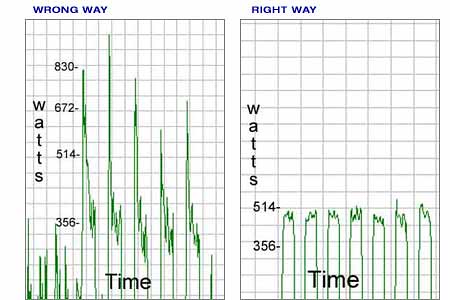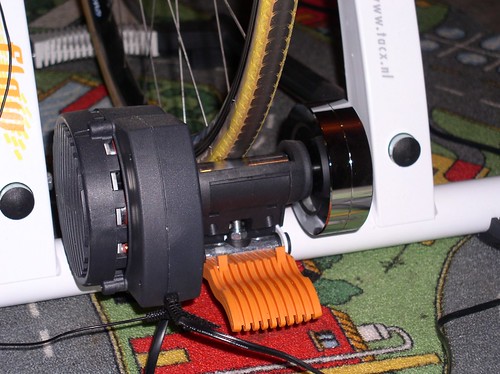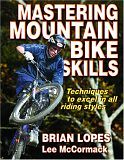Part 3b: How to do intervals
This is part 3b in a series of how I've been training on the Morris Plan
Before I continue with the summary of Off season training I wanted to discuss intervals.
The dreaded intervals. When you do intervals you have graduated from the Hey Man I just ride for fun, to real training. Lots of people avoid them because they don't want to be considered as training. But in practice they are probably doing intervals on every group ride they go on. Ride hard, regroup, ride hard, regroup, etc.
The basic premise behind intervals is that you can accomplish more total work by going hard and then resting, than if you just rode continuously. And by riding at an intensity than is harder than you can maintain for a significant length of time you are 'training' your body to be able to increase how hard it can go.
Some guy said wrt to training and time trialing :
If you never go 30mph, well you'll never go 30mph
There are several variables in intervals than can be manipulated to give you a desired affect.
# of sets
# of reps
Time ON
Time OFF-recovery
Recovery Time between sets
the Intensity at which the interval is done.
For example
3 reps of
5 x 1min ON - 1min OFF
5 minutes between sets
at X intensity.
How you manipulate those variables is up to you. For example, mountain bike racing has lots of high intensity efforts followed by inadequate rest. So one way of simulating this, is to take an interval like 2min ON, 2min OFF that you might have been doing earlier in the year and change it to 2min ON, 1 Min OFF, but try and do it at the same intensity.
Frank Overton a cycling coach has a article on interval training at his web site.
The funadmental rule is: Go as hard as you can BUT only as hard as you can maintain for the duration of your entire interval workout.
So the intensity at which you do 5x1min is going to be significantly higher than what you'd do 2x20min at.
Graphically it looks like this:

Notice that the correct way looks like a square wave, and the incorrect way has a huge peak at the beginning. Now picture the typical blow up in cycling and you see the intensity drop dramatically towards the end of the interval.
TOTAL WORK can be defined as the area under the curve. And you have more total work when you do it like a square wave.
So the big question now is HOW DO YOU MEASURE INTENSITY.
Power measurement rules for this and is taking the cycling world by storm. So if you've got the cash for a SRM,

Power Tap

or other on bike power measuring device well then you are golden.
I think it is easier to concentrate on an interval on an indoor trainer anyway. So there are several trainers that provide an output power measurement ( I just saw some new ones at Nashbar even), and there are a few that are considered ERGO trainers that actually hold the power settings regardless of your cadence or gearing.
The computrainer

is the gold standard with regards to ergo trainers, it also costs a lot. I'm more concerned with the power/ergo ability than all the bells and whistles so you can get a lower model or an older model to save some $. I use a Tacx FLOW

I wrote a review of the Tacx Flow several months ago.
The beauty of an ERGO trainer is the set/forget method of doing an interval. Set the power, put your head down and pedal. With a non ergo trainer, you've got to be watching the ouput and you'll always be above/below and it just requires more focus on that than on acutally riding to puke level.
Ok so if you don't have an ergo trainer or a trainer that measures actual wattage now what? A lot of the good trainers like Kurt Kurt Kinetic, 1Up, Cycleops, etc will provide you with a power curve. So at a set cadence and velocity you will know what the power is. Again it requires some more concentration to maintain constant velocity/cadence. And you will need a rear wheel sensor/computer most likely.
But the premise is that constant grade and constant velocity=constant power.
So another thing you can do is to find a hill that is a constant grade, or a road that is more/less flat and ride a constant velocity using you bike computer.
So what about Hear rate. HR is good, but there is a lag time that really screws up your intervals, especially short ones. It could take more than a minute for your HR to get to stabilize even though you have been riding at the correct power setting for that minute. The tendency is to totally over shoot the proper intensity in the hopes of getting your HR to the target zone as soon as possible.
One other option is that some of those uncomfortable bikes at they gym are actually ergo trainers or have a power output

Before I got my trainer, I used to take my pedals to the gym and remove the pedals on the life cycle and put my SPDs on and do my intervals.
And the old standby is still Perceived Exertion. Get a feel for what the intensity level should be and hold it. Invariably it always feels easier at the beginning than at the end, so remember that.
So that's my take on intervals.



0 Comments:
Post a Comment
<< Home